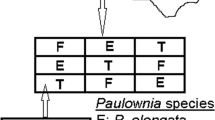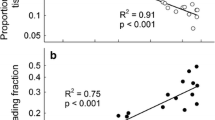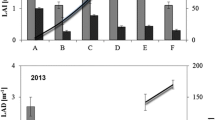Abstract
Vegetative growth and changes within populations ofSyneilesis palmata (THUNB>) MAX. Usannamul were monitored in two natural stands with different levels of incoming light. This perennial, shade-tolerant herb was measured for its plant size, petiole length, leaf breadth, and leaflet number over 11 years in a moderately shaded (MS) stand and over 7 years in a severely shaded (SS) stand. At the end of each growing season, a shoot primordium developed at the center of the root system. Correlation coefficients were mostly high between pairings of two properties - total weight, petiole length, petiole weight, leaf breadth, leaf blade weight, leaf area, specific leaf area, and leaflet number. Mean annual mortality of this species was higher in SS (22.97%) than in MS (8.85%), but great fluctuations were seen from year by year. Mortality was lowest for medium-sized plants. Regarding petiole length, differences in mean annual growth rates were conspicuous, i.e., 2.6% in MS and 8.4% in SS, while growth rates for leaf breadth were 3.1% in MS and 24.2% in SS. Changes in plant frequency within individual size classes roughly showed a normal distribution curve. However, the mode varied year by year, and such changes were more remarkable in SS than in MS. Under severe shading,S. palmata had a higher growth rate and but also greater mortality than did plants under moderate shade. Therefore, one can conclude that the population structure in SS was unstable over time.
Similar content being viewed by others
Literature Cited
Ali MS, Kikuzawa K (2005) Plasticity in leaf-area density within the crownAucuba japonica growing under different light levels. J Plant Res118: 307–316
Bierzychudek P (1982) Life histories and demography of shade-tolerant temperate forest herbs: A review. New Phytol90: 757–776
Casella E, Ceulemans R (2002) Spatial distribution of leaf morphological and physiological characteristics in relation to local radiation regime within the canopies of 3-year-oldPopulus clones in coppice culture. Tree Physiol18: 1277–1288
Dong M, During HJ, Werger MJA (1997) Clonal plasticity in response to nutrient availability in the pseudoannual herb,Trientalis europaea L. Plant Ecol131: 233–239
Grubb PJ, Lee WG, Kollman J, Wilson JB (1996) Interaction of irradiance and soil nutrient supply on growth of seedlings of ten European tall-shrub species andFagus sylvatica. J Ecol84: 827–841
Harper JL (1977) Population Biology of Plants. Academic Press, London
Holland PG (1981) The demography of trout lily (Erythronium americanum Ker.) in Nova Scotia. Vegetatio45: 97–106
Inghe O, Tamm CO (1985) Survival and flowering of perennial herbs: IV. The behaviour ofHepatica nobilis andSanicula europaea on permanent plots during 1943-1981. Oikos45: 400–420
Kawano S (1985) Life history characteristics of temperate woodland plants in Japan,In J White, ed, The Population Structure of Vegetation. Dr W Junk Publishers, Dordrecht, pp 515–549
Kawano S, Nagai Y (1975) The productive and reproductive biology of flowering plants: I. Life history strategies of threeAllium species in Japan. Bot Mag Tokyo88: 281–318
Kudoh H, Shibaike H, Takasu H, Whigham DF, Kawano S (1999) Genetic structure and determinants of clonal structure in a temperate deciduous woodland herb,Uvularia perfoliata. J Ecol87: 244–257
Min BM (2000a) Population dynamics ofHeloniopsis orientalis C. Tanaka (Liliaceae) in natural forests: Annual life cycle. J Plant Biol43: 189–196
Min BM (2000b) Population dynamics ofHeloniopsis orientalis C. Tanaka (Liliaceae) in natural forests: Population growth and population structure. J Plant Biol43: 197–207
Min BM (2006) Morphological adaptations byGlehnia littoralis to the biomass and heights of peripheral herbaceous plants in coastal sand dune. J Plant Biol49: 123–132
Min BM (2007) Population ecology in natural Syneilesis palmata stands: I. Relationship between flowering and plant size. J Plant Biol 50: (in press)
Mitchell AK (1998) Acclimation of Pacific yew (Taxusbrevifolia) foliage to sun and shade. Tree Phyiol18: 749–757
Robinson SA, McCarthy BC (1999) Growth responses ofCarya ovata (Juglandaceae) seedlings to experimental sun patches. Amer Midland Natur141: 69–84
Silvertown JW (1982) Introduction to Plant Population Ecology. Longman Group, New York, p 2
Simioni G, Gignoux J, le Roux X, Appe R, Benest D (2004) Spatial and temporal variations in leaf area index, specific leaf area and leaf nitrogen of two co-occurring savanna tree species. Tree Physiol24: 205–216
Tamm CO (1956) Further observations on the survival and flowering of some perennial herbs. Oikos7: 274–292
Tamm CO (1972a) Survival and flowering of perennial herbs: II. The behaviour of some orchids on permanent plots. Oikos23: 23–28
Tamm CO (1972b) Survival and flowering of perennial herbs: III. The behaviour ofPrimula veris on permanent plots. Oikos23: 159–166
Verburg RW, During H (1998) Vegetation propagation and sexual reproduction in woodland understory pseudo-annualCircaea lutetiana L. Plant Ecol134: 211–224
Verburg RW, Kwant R, Werger MJA (1996) The effect of plant size on vegetative reproduction in a pseudo-annual. Vegetation125: 185–192
Wijesinghe DX, Whigham DF (1997) Costs of producing clonal offspring and the effects of plant size on population dynamics of the woodland herbUvularia perfoliata (Liliaceae). J Ecol85: 907–919
Author information
Authors and Affiliations
Corresponding author
Rights and permissions
About this article
Cite this article
Min, B.M. Population ecology in a naturalsyneilesis palmata stand: II. vegetative growth and population structure. J. Plant Biol. 50, 423–429 (2007). https://doi.org/10.1007/BF03030678
Received:
Accepted:
Issue Date:
DOI: https://doi.org/10.1007/BF03030678




